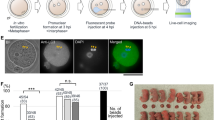Abstract
MOST cells contain deoxyribonucleases but do not degrade their nuclear DNA. This paradox is sometimes explained by assuming that the nucleuses do not have access to DNA, from which they may be separated by the nuclear membrane. Another possibility is that cells contain a component which stabilises DNA even in the presence of nucleases. We show here that such a component is present in the frog oocyte, a type of cell in which deoxyribonucleases have been repeatedly demonstrated1,2. Although we have not characterised this component, we show that it is localised in the nucleus; it seems to be absent from cytoplasm but may leak into it when the nuclear membrane is ruptured. The DNA whose stability we have investigated is a small circular molecule introduced into the oocyte by microinjection, but the conclusions probably apply also to the endogenous nuclear DNA of the oocyte, and perhaps to the nuclear DNA of eukaryotic cells in general.
This is a preview of subscription content, access via your institution
Access options
Subscribe to this journal
Receive 51 print issues and online access
$199.00 per year
only $3.90 per issue
Buy this article
- Purchase on Springer Link
- Instant access to full article PDF
Prices may be subject to local taxes which are calculated during checkout
Similar content being viewed by others
References
Ford, C. C., Pestell, R. Q. W. & Benbow, R. M. Devl Biol 43, 175–188 (1975).
Mattoccia, E., Attardi, D. G. & Tocchini-Valentini, G. P. Proc. natn. Acad. Sci. U.S.A. 73, 4551–4554 (1976).
Hewish, D. R. & Burgoyne, L. A. Biochem. biophys. Res. Commun. 52, 504–510.
Mertz, J. E. & Gurdon, J. B. Proc. natn. Acad. Sci. 74, 1502–1506 (1977).
Brown, D. D. & Gurdon, J. B. Proc., natn. Acad. Sci. U.S.A. 74, 2064–2068 (1977).
Gurdon, J. B. Proc. R. Soc. B 176, 303–314 (1970).
Bonner, W. M. J. Cell Biol. 64, 421–430 (1975).
Bonner, W. M. J. Cell Biol. 64, 431–437 (1975).
Merriam, R. W. & Hill, R. J. J. Cell Biol. 69, 659–668 (1976).
Laskey, R. A. & Gurdon, J. B. Eur. J. Biochem. 37, 467–471 (1973).
Kerr, J. F. R., Wyllie, A. H. & Currie, A. R. Br. J. Cancer 26, 239–257 (1972).
Gurdon, J. B. J. Embryol. exp. Morph. 36, 523–540 (1976).
Tegtmeyer, P. & Macasaet, F. J. Virol. 10, 599–604 (1972).
Laskey, R. A., Mills, A. D. & Morris, N. R. Cell 10, 237–243 (1977).
Author information
Authors and Affiliations
Rights and permissions
About this article
Cite this article
WYLLIE, A., GURDON, J. & PRICE, J. Nuclear localisation of an oocyte component required for the stability of injected DNA. Nature 268, 150–152 (1977). https://doi.org/10.1038/268150a0
Received:
Accepted:
Issue Date:
DOI: https://doi.org/10.1038/268150a0
This article is cited by
-
Intracellular transport of microinjected 5S and small nuclear RNAs
Nature (1982)
-
Transcription of cloned Xenopus ribosomal genes visualised after injection into oocyte nuclei
Nature (1978)
-
Intracellular migration of nuclear proteins in Xenopus oocytes
Nature (1978)
-
Correlation between deoxyribonuclease activity and DNA replication in the embryonic axes of germinating peas (Pisum sativum L.)
Planta (1978)
Comments
By submitting a comment you agree to abide by our Terms and Community Guidelines. If you find something abusive or that does not comply with our terms or guidelines please flag it as inappropriate.



